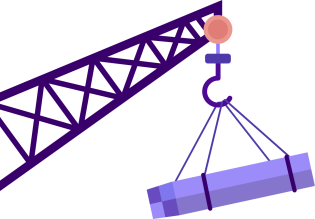A Guide to Mastering Civil Project Planning

Whether you’re an experienced professional or a newcomer to the field, effective project planning can make the difference between a smooth operation and a chaotic endeavor. This guide aims to provide valuable insights and practical tips for mastering civil project planning in the field service industry.
Understanding Resource Plan Management
Resource Management Plan is a critical component of project management that outlines how various resources—human, financial, equipment, and materials—will be utilized, allocated, and controlled throughout the course of a project. The goal of resource management planning is to ensure that resources are efficiently and effectively employed to achieve project objectives within defined constraints, such as time and budget.

8 Key Components of Construction & Civil Engineering Projects
Project Planning:
- Scope Definition: Clearly defining the project’s goals, deliverables, and objectives.
- Budgeting: Allocating financial resources for materials, labour, equipment, and other project-related expenses.
- Scheduling: Creating a timeline that outlines the sequence of tasks and milestones to ensure timely completion.
- Risk Assessment: Identifying potential risks and developing strategies for risk mitigation.
Resource Management:
- Labour: Coordinating and managing the workforce, including hiring, training, and scheduling.
- Materials: Procuring and managing construction materials to ensure they are available when needed.
- Equipment: Planning and overseeing the use of construction equipment and machinery.
Communication and Collaboration:
- Stakeholder Communication: Facilitating effective communication among project stakeholders, including owners, architects, contractors, and regulatory authorities.
- Team Collaboration: Ensuring collaboration and coordination among different teams involved in the project.
Quality Management:
- Quality Assurance: Implementing processes to ensure that construction work meets specified standards and regulations.
- Quality Control: Monitoring and inspecting work to identify and address any issues affecting the project’s quality.
Contract Management:
- Contract Negotiation: Developing and negotiating contracts with suppliers, civil engineers, subcontractors, and other project partners.
- Contract Administration: Ensuring that all parties involved in the project adhere to the terms and conditions outlined in contracts.
Safety Management:
- Safety Planning: Developing safety plans and protocols to ensure a secure working environment.
- Regulatory Compliance: Ensuring that the construction project complies with local, state, and federal safety regulations.
Monitoring and Control:
- Project Monitoring: Regularly tracking and evaluating project progress against the established plan and schedule.
- Issue Resolution: Addressing and resolving any challenges or obstacles that arise during construction.
Project Closeout:
- Documentation: Compiling and organizing project documentation, including “as-built” drawings and manuals.
- Client Handover: Handing over the completed project to the client and addressing any outstanding issues.
Construction Project Management requires a diverse skill set, including leadership, communication, problem-solving, and technical expertise. Project managers in this field play a critical role in ensuring the successful delivery of construction projects while managing resources efficiently and maintaining high-quality standards.
Learn more about the Power of Preventative Maintenance!
Understanding the Project Scope
The foundation of any successful project lies in a clear understanding of the scope. Define the project objectives, deliverables, and constraints before diving into the planning phase. Consider factors such as budget, timeline, and resources available. A well-defined scope sets the stage for a comprehensive project plan.
- Collaborative Planning: Field service projects often involve multiple stakeholders, including engineers, contractors, and clients. Foster collaboration by involving all relevant parties in the planning process. Regular communication ensures that everyone is on the same page, reducing the chances of misunderstandings and project delays.
- Risk Assessment and Management: Identifying potential risks is crucial in civil project planning. Assess the environmental, technical, and logistical risks associated with the project. Develop a risk management plan that outlines strategies for mitigating and responding to potential issues. Proactive risk management can save both time and resources in the long run.
- Utilizing Technology: In the modern field service industry, technology plays a pivotal role in project planning. Embrace project management tools, Building Information Modeling (BIM), and other digital solutions to enhance efficiency. These technologies not only streamline the planning process but also facilitate real-time collaboration and data sharing.
- Resource Optimization: Efficient resource allocation is key to successful project planning. Identify the required equipment, materials, and manpower for each phase of the project. Optimize resource allocation to avoid bottlenecks and ensure a smooth workflow. This includes considering factors such as equipment availability, skill sets of the workforce, and logistics.
- Adaptability and Flexibility: Civil projects are often subject to unforeseen changes, such as weather conditions, regulatory updates, or unexpected site challenges. Build flexibility into your project plan to accommodate these changes. A well-thought-out contingency plan ensures that the project stays on track even in the face of unexpected obstacles.
- Continuous Monitoring and Evaluation: Regularly monitor project progress against the established milestones. Utilize Key Performance Indicators (KPIs) to assess the effectiveness of the project plan. Conduct periodic evaluations to identify areas for improvement and implement adjustments as needed. Continuous monitoring ensures that the project stays aligned with the initial objectives.
- Documentation and Reporting: Maintain detailed documentation throughout the project lifecycle. This includes project plans, progress reports, and communication logs. Clear documentation provides a historical record of decisions, changes, and project milestones. It also serves as a valuable resource for post-project analysis and future planning.
Master Your Project Management
Mastering civil project planning in the field service industry requires a combination of strategic thinking, collaboration, and adaptability. By understanding the project scope, fostering collaboration, managing risks, leveraging technology, optimizing resources, and maintaining flexibility, professionals in the field service industry can navigate the complexities of civil projects with confidence.
?Continuous monitoring, documentation, and a commitment to improvement further contribute to successful project outcomes. Embrace these principles, and you’ll be well on your way to becoming a master of civil project planning in the field service industry.
The All-In-One Platform
Ready to revolutionize your field service management? Look no further than FieldInsight! Centralize your job life cycles and streamline asset maintenance for sustainable and profitable growth.
With FieldInsight, you can seamlessly synchronize the field to the office, ensuring a smooth flow from quotes and service delivery to invoicing and detailed reports. Our comprehensive platform empowers you to take control of your projects, enhance collaboration among your teams, and ultimately drive success in the field service industry.
Don’t miss out on the opportunity to optimize your operations and elevate your business to new heights. Visit FieldInsight today and discover how we can transform your field service management for increased efficiency and profitability. Your journey to a more streamlined and successful business starts here!
What You Should Do Now
- Book a Demo. You’ll be in touch with an automation expert who has worked in this space for over 5 years, and knows the optimal workflow to address your needs.
- If you’d like access to free articles about managing HVAC workflows, go to our blog.
- If you know someone who’d enjoy reading this page, share it with them via email, Linkedin, Twitter, or Facebook.





